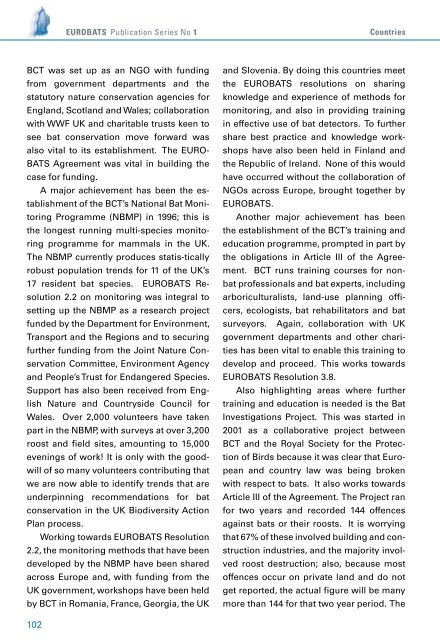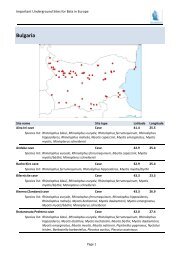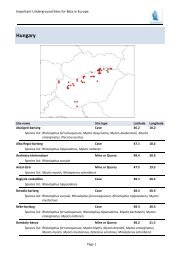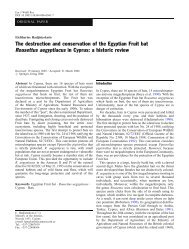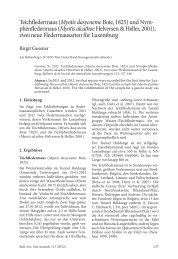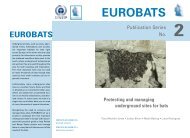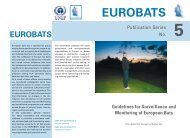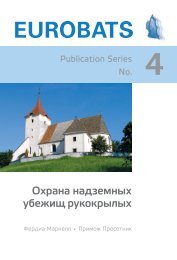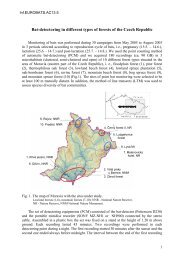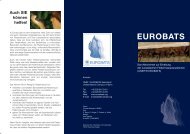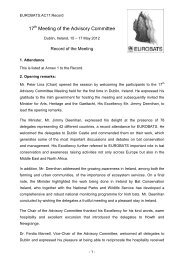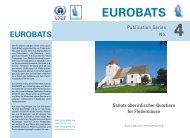1991 - 2006. EUROBATS celebrates its 15th anniversary
1991 - 2006. EUROBATS celebrates its 15th anniversary
1991 - 2006. EUROBATS celebrates its 15th anniversary
You also want an ePaper? Increase the reach of your titles
YUMPU automatically turns print PDFs into web optimized ePapers that Google loves.
102<br />
<strong>EUROBATS</strong> Publication Series No 1 Countries<br />
BCT was set up as an NGO with funding<br />
from government departments and the<br />
statutory nature conservation agencies for<br />
England, Scotland and Wales; collaboration<br />
with WWF UK and charitable trusts keen to<br />
see bat conservation move forward was<br />
also vital to <strong>its</strong> establishment. The EURO-<br />
BATS Agreement was vital in building the<br />
case for funding.<br />
A major achievement has been the establishment<br />
of the BCT’s National Bat Monitoring<br />
Programme (NBMP) in 1996; this is<br />
the longest running multi-species monitoring<br />
programme for mammals in the UK.<br />
The NBMP currently produces statis-tically<br />
robust population trends for 11 of the UK’s<br />
17 resident bat species. <strong>EUROBATS</strong> Resolution<br />
2.2 on monitoring was integral to<br />
setting up the NBMP as a research project<br />
funded by the Department for Environment,<br />
Transport and the Regions and to securing<br />
further funding from the Joint Nature Conservation<br />
Committee, Environment Agency<br />
and People’s Trust for Endangered Species.<br />
Support has also been received from English<br />
Nature and Countryside Council for<br />
Wales. Over 2,000 volunteers have taken<br />
part in the NBMP, with surveys at over 3,200<br />
roost and field sites, amounting to 1 ,000<br />
evenings of work! It is only with the goodwill<br />
of so many volunteers contributing that<br />
we are now able to identify trends that are<br />
underpinning recommendations for bat<br />
conservation in the UK Biodiversity Action<br />
Plan process.<br />
Working towards <strong>EUROBATS</strong> Resolution<br />
2.2, the monitoring methods that have been<br />
developed by the NBMP have been shared<br />
across Europe and, with funding from the<br />
UK government, workshops have been held<br />
by BCT in Romania, France, Georgia, the UK<br />
and Slovenia. By doing this countries meet<br />
the <strong>EUROBATS</strong> resolutions on sharing<br />
knowledge and experience of methods for<br />
monitoring, and also in providing training<br />
in effective use of bat detectors. To further<br />
share best practice and knowledge workshops<br />
have also been held in Finland and<br />
the Republic of Ireland. None of this would<br />
have occurred without the collaboration of<br />
NGOs across Europe, brought together by<br />
<strong>EUROBATS</strong>.<br />
Another major achievement has been<br />
the establishment of the BCT’s training and<br />
education programme, prompted in part by<br />
the obligations in Article III of the Agreement.<br />
BCT runs training courses for nonbat<br />
professionals and bat experts, including<br />
arboriculturalists, land-use planning officers,<br />
ecologists, bat rehabilitators and bat<br />
surveyors. Again, collaboration with UK<br />
government departments and other charities<br />
has been vital to enable this training to<br />
develop and proceed. This works towards<br />
<strong>EUROBATS</strong> Resolution 3.8.<br />
Also highlighting areas where further<br />
training and education is needed is the Bat<br />
Investigations Project. This was started in<br />
2001 as a collaborative project between<br />
BCT and the Royal Society for the Protection<br />
of Birds because it was clear that European<br />
and country law was being broken<br />
with respect to bats. It also works towards<br />
Article III of the Agreement. The Project ran<br />
for two years and recorded 144 offences<br />
against bats or their roosts. It is worrying<br />
that 67% of these involved building and construction<br />
industries, and the majority involved<br />
roost destruction; also, because most<br />
offences occur on private land and do not<br />
get reported, the actual figure will be many<br />
more than 144 for that two year period. The


